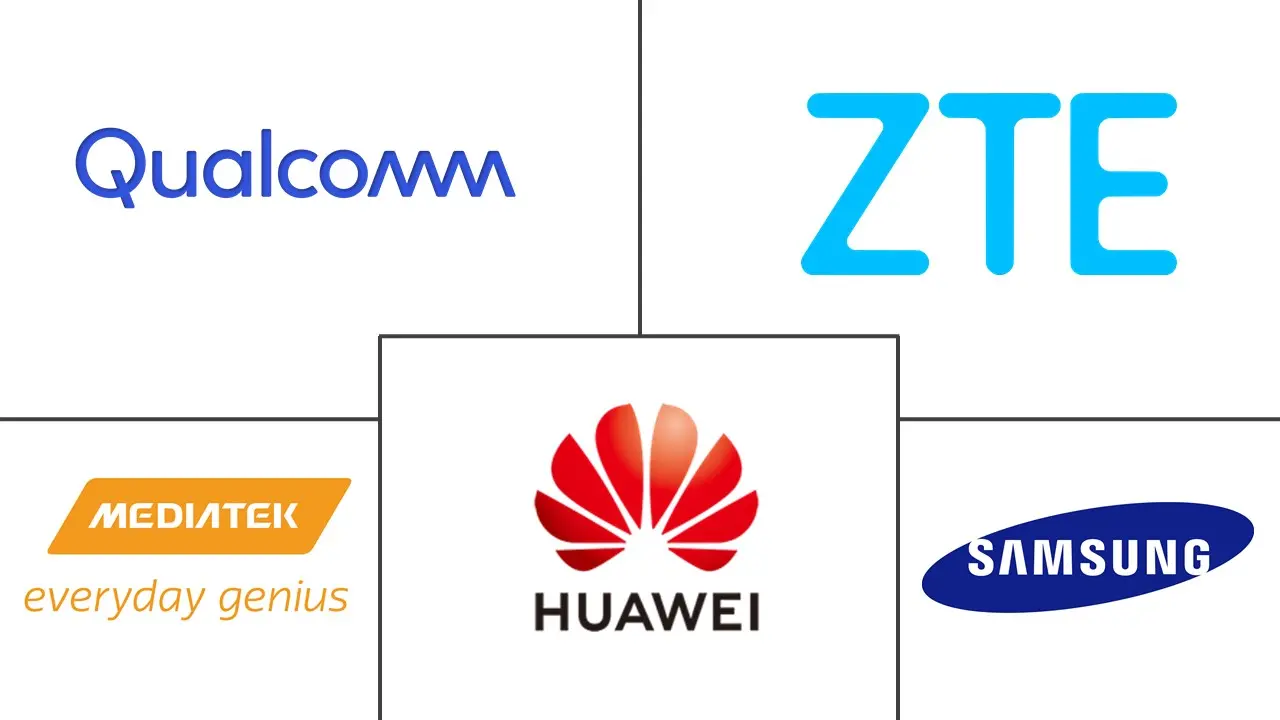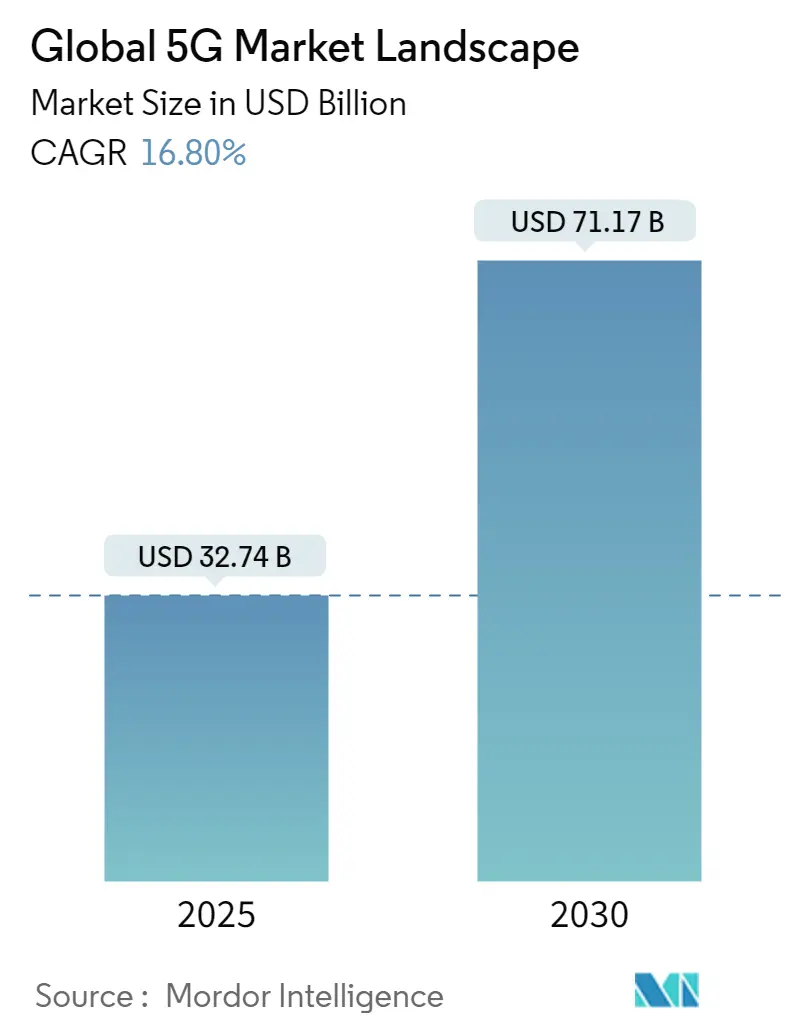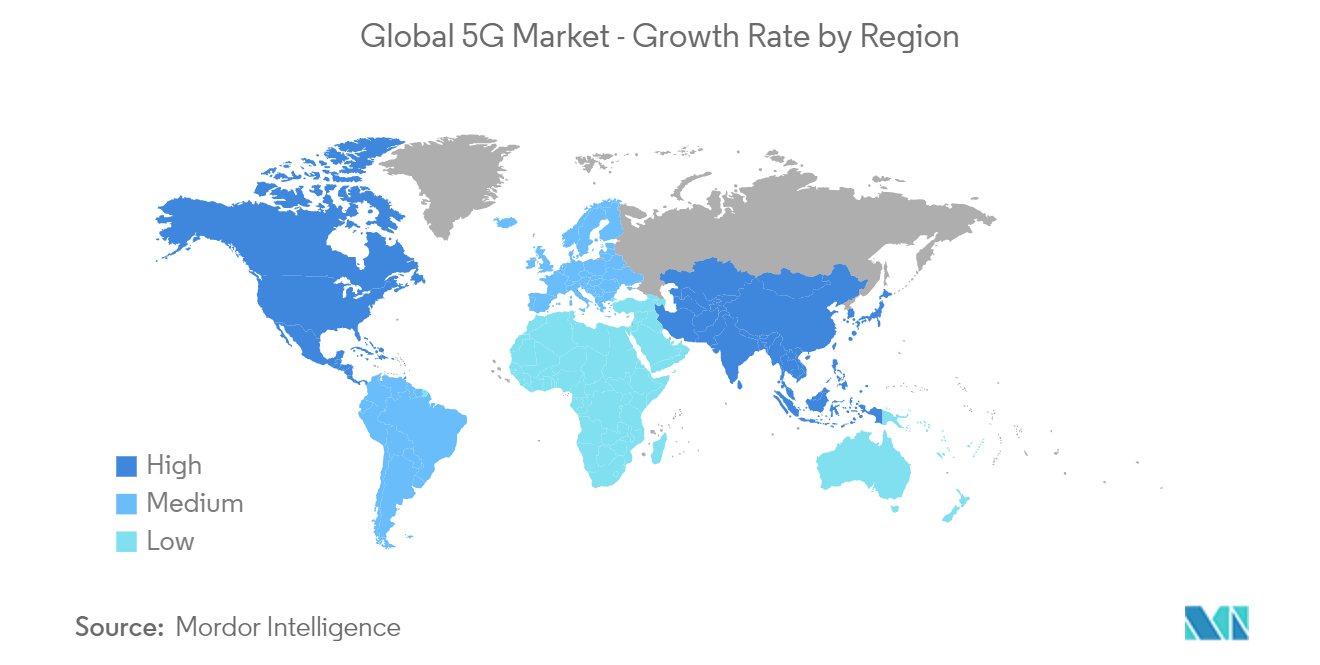5G Market Analysis
The Global 5G Market size is estimated at USD 32.74 billion in 2025, and is expected to reach USD 71.17 billion by 2030, at a CAGR of 16.8% during the forecast period (2025-2030).
With seamless coverage, high data rates, low latency, much better performance, and efficient communications, the 5G network-the next generation of mobile networking standards-is ready to provide an improved end-user experience.
The sphere of smartphones will be one of many things that will be impacted by 5G connectivity. Infrastructural advancements in the Internet of Things (IoT) and Machine-to-Machine (M2M) have, for example, long been constrained by the slow download speeds and latency of 4G. The cumulative effect of any latency will be more significant and observable as more devices are connected to a network and communicating with one another. For instance, augmented reality will eventually enable wearable technology to seamlessly integrate with people's daily lives due to increased speed and bandwidth. Instantaneous communication amongst autonomous vehicles will be quite advantageous for them as well.
Additionally, 5G will dramatically improve smart city services for public security and safety. In instances like a car accident or terrorist attack, real-time analytics of video recordings from public spaces combined with biometric software will be able to identify unsafe circumstances and automatically warn authorities instantly. Contrary to current CCTV systems, 5G-enabled equipment will be able to get updates wirelessly, and data management platforms will link different services. Additionally, 5G connected equipment will be extended to mobile form factors like drones and robots and be able to be installed everywhere there is mobile network coverage, doing away with the requirement for fixed wire.
Furthermore, national governments aiding the expansion of smart city projects is also a key trend in the market. With the support of the Ministry of Housing and Urban Affairs in India, the nation aims to develop 4,000 cities to house a population of 5,00,000 each by 2023. Moreover, in England, Sunderland City Council awarded a 20-year strategic partnership to BAI Communications to design, build and operate next-generation digital infrastructure, including a private 5G small cell network, in October 2021. The New 5G network will realize Sunderland City Council's ambition to be a fully digitally enabled smart city.
Indeed, more than ever, consumers and professionals depend on reliable, fast internet performance after the COVID-19 pandemic, which has increased demand for connectivity. For instance, pandemic restrictions prompted the closure of numerous enterprises and industrial facilities, causing manufacturing processes and supply chains to be disrupted. Remotely controlled devices with 5G communication suddenly became essential. They made it possible for human drivers to operate cranes, drones, and other industrial machinery more quickly, accurately, and from a distance. This is just one of the many ways that 5G could be important for assisting businesses to continue operating and be resilient in the face of any future disruption.
On the flip side, a 5G connection is expected to add multiple layers of complexity to the spectrum due to the all-inclusive nature of services. Limited spectrum availability is a big challenge in the development of 5G. The bandwidth requirements of 5G mean a higher frequency spectrum would be fundamental in delivering high-speed, high-quality connectivity. The 5G standard, which uses millimeter waves, is a lot shorter than the wavelengths 4G uses. The shorter wavelength means a 5G connection can carry much data faster than 4G, but it also means a significantly shorter range. 4G wavelengths have a range of almost 10 miles. 5G wavelengths range about 1,000 feet, not even 2% of 4G's coverage. So, to ensure a robust 5G signal, there is a requirement for many 5G cell towers and antennas everywhere, increasing the setup cost.
5G Market Trends
5G Devices are One of the Factors Driving the Market
- According to GSMA, a new wave of the 5G rollouts in large economies with modest income levels (such as Brazil, Indonesia, and India) could encourage the mass production of 5G devices that are more accessible to lower-income people. It might also encourage the creation of brand-new 5G business and consumer applications in developing regions, given that most 5G applications and use cases to date have been concentrated on more developed markets. In the meantime, the average retail price of a 5G phone has now dropped below USD 500, with some suppliers, like Realme, offering smartphones for less than USD 150. This encourages 5G uptake in less developed regions and creates an opportunity for cutting-edge services based on the technology.
- Further, according to Ericsson, global 5G subscriptions are anticipated to jump dramatically between 2019 and 2027, from over 12 million to over 4 billion subscriptions. The regions with the most significant anticipated subscription numbers include North East Asia, South East Asia, India, Nepal, and Bhutan. Additionally, the GSMA predicts that by 2025, 5G connections will make up more than half of all mobile connections in the Developed Asia Pacific, North America, and Greater China.
- Moreover, laptop manufacturers are incorporating 5G technology to capture a wide market share. For instance, last year, Intel, a chipmaker, offered the new 5G Solution 5000 modem in laptops from Acer, ASUS, and HP in more than 30 laptop models. Additionally, Intel is enhancing its Tiger Lake series of 5GHz-capable ultra-thin notebooks. The Intel 5G Solution 5000 is an M.2 module that has received certification for global coverage from AT&T and Spring, among other carriers. Intel can provide upload and download speeds of up to 1.25 and 4.7 Gbps, respectively.
- Further, in October this year, Hyundai Mobis claimed to have created a 5G-based communication module for automobiles to enhance the performance of connected car systems, including autonomous driving. This module enables real-time, large-volume data processing. According to the provider, the new module uses ultra-high speed, ultra-low latency, and hyper-connection technologies to combine memory and communication operations, as well as radio frequency circuits and GPS.
- On the contrary, as most of the smartphone companies in the United States rely on a wide range of target audiences for 5G devices, this may affect the consumers' choice to upgrade to 5G. According to the NPD Group, US smartphone users hold on to their smartphones for more extended periods, which has presented a challenge for the smartphone market in the recent past. Manufacturers and carriers are expecting 5G to help reinvigorate the upgrade cycle. However, pricing could present another hurdle.
China Holds Prominent Share of the Market
- China is expected to lead the early deployment of 5G-capable vehicles, apex from strong early support from the domestic government in infrastructure capabilities, advanced research and development from the local supply chain, and consumers' appetite for the upcoming technology inside and outside of the vehicle. The fact that these vehicles will be exclusive to China's large domestic market further streamlines adoption because 5G infrastructure and standards are very likely to be standardized across the territory.
- According to the Government Services and Data Management Bureau of Nanshan District, to support city-level administration and services, Nanshan, a developed administrative region in the first-tier city, adheres to a thorough top-level design plan powered by cutting-edge 5G + technology. The program addresses the majority's most urgent requirements by considering governance, public services, and industry development. A super-large city-level cognitive network with 5G + IoT capability has been developed from terminals to networks. It reshapes the coupling effects of 5G + smart cities by presenting growth trends of the urban 5G sector in a panoramic, layered, and dynamic manner.
- Similarly, according to the Bureau of Emergency Management of Lishui, in Zhejiang Province, Lishui is the prefecture-level city with the most significant land area. The city experiences a variety of calamities that frequently occur and result in substantial losses due to its almost 90% forest coverage, 5% water content, and 5% farm area. A visualization system is essential for making informed decisions, effective command and scheduling, and resolving situations promptly. Based on the demands of the Bureau of Emergency Management for the benefit of people's livelihood, Lishui 5G emergency visualization system is a platform integrating cloud, management, and terminal. The platform offers features like disaster early warning, remote search and rescue, and satellite communication thanks to the 5G network, 5G mobile cabin, and other capabilities.
- Further, in the tropical province of Hainan, a 5G smart healthcare network integrating MEC and AI, developed by China Unicom and Huawei, has increased the efficiency and reach of medical services. Each municipal and county hospital, as well as 340 township health centers and 2693 village clinics, all have telemedicine equipment installed. The network offers remote consultations and diagnosis with AI assistance. Average patient wait times have been cut in half, while medical treatment effectiveness has increased by 30%.
- Moreover, China is also witnessing an upward trend in smart manufacturing plants where M2M communication is crucial to the efficient function of the entire plant. Therefore, the increasing uptake of these technologies by various end-user industries is leading to increased development in 5G connections. For instance, the RoboTechnik plant in Suzhou, Jiangsu Province, is moving towards a complete 5G-enabled smart plant. The prototype plant planned to install a 5G network to replace the fixed lines and Wi-Fi connections at the operational layer to make the equipment more intelligent and facilitate the transformation of the industrial applications to the cloud to achieve flexible and smart manufacturing.
5G Industry Overview
The 5G market Landspace is highly consolidated. All the companies involved in the production continue to enhance their product offerings frequently, leveraging their high R&D capabilities and investments, leaving the current market scenario highly competitive and mostly market incumbents.
In August 2022, Chinese chip manufacturer UNISOC released its second-generation 5G chip in the second half of 2022 or the first part of 2023. Extreme ultraviolet (EUV) technology, a crucial process for advanced chip manufacturing, was reportedly used by UNISOC to start mass-producing 6nm 5G devices. UNISOC already has three distinct types of 5G chips on the market.
In May 2022, MediaTek introduced Dimensity 1050 system-on-chip [SoC], the company's first mmWave 5G chipset, which offers seamless connection, displays, gaming, and power efficiency. Dimensity 930 and Helio G99 are two other chipsets that were also introduced as part of the company's expansion of its 5G and gaming chipset families. The Dimensity 1050 is constructed using an octa-core CPU and the TSMC 6nm fabrication process, combining mmWave 5G and sub-6GHz to aid network spectrum migration.
5G Market Leaders
-
Qualcomm Technologies Inc.
-
Samsung Group
-
Huawei Technologies Co. Ltd
-
ZTE Corporation
-
MediaTek Inc.
- *Disclaimer: Major Players sorted in no particular order
5G Market News
- October 2022: Fibocom, a Chinese manufacturer of communication devices, introduced the FX170(W) Series, a new generation of 5G Sub-6GHz and mmWave Modules. It is powered by the Snapdragon X65 5G Modem-RF System and provides a wireless communication experience similar to fiber with enhanced network coverage, faster throughput, and more functionality. The Fibocom FX170(W) modules come in four different configurations that independently use the land grid array (LGA) and M.2 form factors and adhere to the 3GPP R16 standard.
- September 2022: With the 5G roll-out launch in India, Quectel Wireless Solutions announced that its technologies and services were prepared to introduce 5G devices to the Indian market. The RM510Q-GL, RM50xQ, and RG50xQ are three 5G modules from Quectel that are available to service the Indian market. They are all based on Qualcomm chipsets. These modules allow standalone and non-standalone 5G, providing 3G and 4G fallback with optional integrated SIM (iSIM) capabilities.
5G Industry Segmentation
The Global 5G Market Landscape analyzes the overall market landscape of the 5G industry, with detailed coverage on 5G Adoption (Macro cell-Site, Small cell site), 5G Connections (Mobile Broadband, Fixed Wireless Access, M2M&IoT, Mission Critical), 5G Devices (by form factor(smartphone, CPE(indoor, outdoor), modules, hotspot, laptops, industrial grade ), by spectrum support (sub-6 GHz, mmwave), 5G Chipset (by IC type (RFIC, ASIC, mmWave IC, cellular IC), by Deployment (device, CPE, network infrastructure) and by region.
The market sizes and forecasts are provided in terms of value (USD million) for all the above segments.
| Number of 5G Devices, by Form Factor | Smartphone |
| CPE (Indoor/Outdoor) | |
| Modules | |
| Hotspots | |
| Laptops | |
| Industrial Grade CPE/Router/Gateway | |
| Other Form Factors(Drones, HMDs, Tablets, TV, Dongles, etc.) | |
| Number of 5G Devices, by Spectrum support | Sub-6 GHz |
| mmWave | |
| Both Spectrum Bands |
5G Market Research FAQs
How big is the Global 5G Market?
The Global 5G Market size is expected to reach USD 32.74 billion in 2025 and grow at a CAGR of 16.80% to reach USD 71.17 billion by 2030.
What is the current Global 5G Market size?
In 2025, the Global 5G Market size is expected to reach USD 32.74 billion.
Who are the key players in Global 5G Market?
Qualcomm Technologies Inc., Samsung Group, Huawei Technologies Co. Ltd, ZTE Corporation and MediaTek Inc. are the major companies operating in the Global 5G Market.
Which is the fastest growing region in Global 5G Market?
Asia-Pacific is estimated to grow at the highest CAGR over the forecast period (2025-2030).
Which region has the biggest share in Global 5G Market?
In 2025, the North America accounts for the largest market share in Global 5G Market.
What years does this Global 5G Market cover, and what was the market size in 2024?
In 2024, the Global 5G Market size was estimated at USD 27.24 billion. The report covers the Global 5G Market historical market size for years: 2019, 2020, 2021, 2022, 2023 and 2024. The report also forecasts the Global 5G Market size for years: 2025, 2026, 2027, 2028, 2029 and 2030.
Our Best Selling Reports
5G Industry Report
Statistics for the 2025 Global 5G Landscape market share, size and revenue growth rate, created by Mordor Intelligence™ Industry Reports. Global 5G Landscape analysis includes a market forecast outlook for 2025 to 2030 and historical overview. Get a sample of this industry analysis as a free report PDF download.







